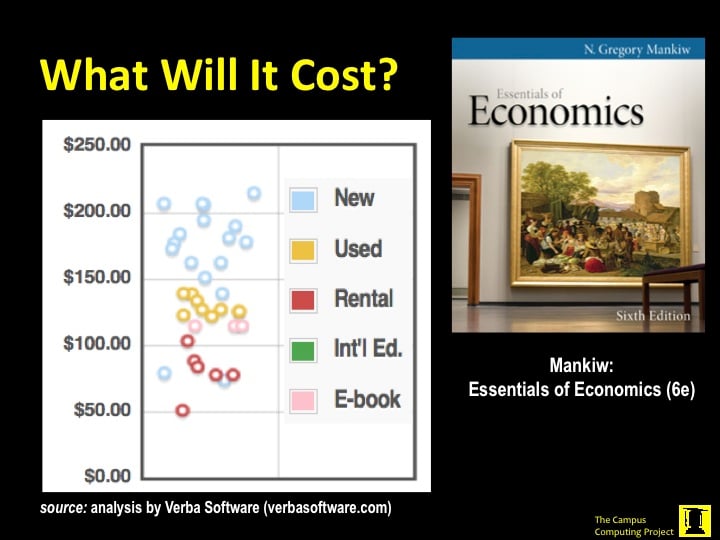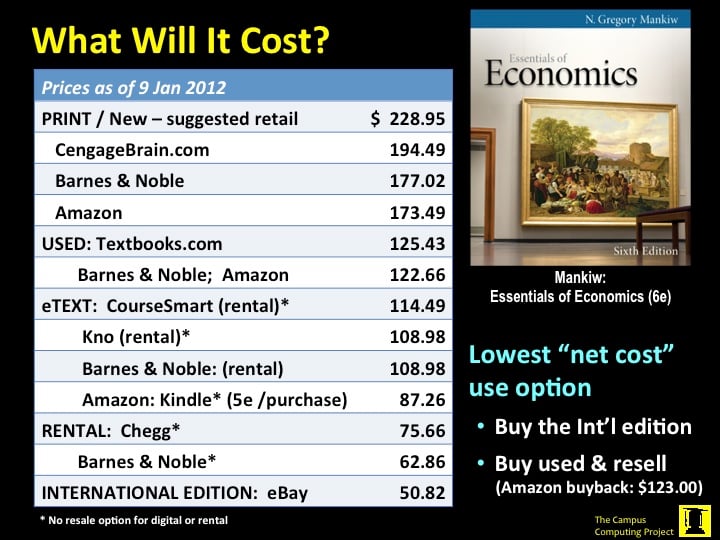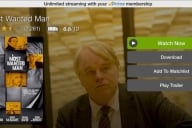You have /5 articles left.
Sign up for a free account or log in.
This past fall fully 90 percent percent of the CIOs who participated in the annual Campus Computing Survey agreed that “eBook content will be an important source for instructional resources in five years,” up from 76 percent in fall 2009. Campus IT leaders were also bullish, if slightly less so, on the rising role of eReaders as a “platform for instructional content” (82 percent agreed in fall 2011, compared to 66 percent in 2009).
The campus market for digital curricula is, indeed, marked by great expectations. Accompanying these expectations for the impending digitalization of curricula materials (textbooks and other resources) are the underlying assumptions that (a) college students, as digital natives, will accept and embrace digital course materials, and (b) digital content (eTexts) will cost less than traditional (printed) tomes.
The time has come to reassess these expectations, drawing on current data on both acceptance and pricing.
Let’s begin with acceptance. Student Monitor’s fall 2011 survey of undergraduates suggests that the student interest in and acceptance of eTexts is lukewarm, at best:
- Less than a fifth (17 pct.) of full-time undergraduates had purchased an eText.
- Less than a third (27 pct.) of full-time undergraduates reported being “very interested” in buying digital books for personal reading (as opposed to required reading for their college courses).
- Just one percent (1 pct.) of the textbooks used by undergraduates in fall 2011 were in digital format (eTexts).
- Among students who had experience with eTexts, the major drivers for eText use was that “my professor required me” to do so (35 pct.), followed by “less expensive than a traditional textbook” (30 pct.).
- Among students who had no direct experience with eTexts, two-fifths (40 pct.) stated that they “don’t like reading on a screen for a long period of time” while a third (34 pct.) reported that they “prefer traditional printed textbooks” to eTexts.
Also significant are data from Student Monitor’s spring 2011 national survey of undergrads: asked about their preferred format for textbooks if price were not an issue (i.e., if all formats such as new, used, rental, and digital the same price), three-fifths (60 percent) of the survey participants said they would buy a new book, only 4 percent wanted to download an eText, and fully a sixth (17 percent) expressed a preference for a used textbook, suggesting that many undergraduates see real value in the marginal notes and highlighting provided by other students. In sum, these data confirm that despite status their status as digital natives, undergraduates have not (yet) embraced digital texts.
One explanation for the lack of student interest in eTexts may be the price: current eText products have yet to deliver on the widespread expectation that “digital should cost less.” However, my (admittedly quick) scan of the textbook market suggests that eTexts are actually among the more expensive textbook options for students.
Updating my August 2010 exploration on eTexts, earlier this week I went the web to search for a copy of The Essentials of Economics (6th edition) by Harvard professor N. Gregory Mankiw. Data (below) provided by Verba Software, document the wide range of prices for various formats of the Mankiw textbook.
Several web sites indicate that the suggested retail price for a new copy of this printed tome is $228; Amazon, Barnes & Noble, and CengageBrain (among others) sell the new book at a discount than runs from 15 to 25 percent (see table). Used print copies of Essentials are available from Amazon, Barnes & Noble, and Textbooks.com, among others, for almost half off of the suggested retail price of a new book.
Renting print copies of Essentials seems, at face value, significantly less expensive than buying either new or used copies of the textbook. However, digital versions of Essentials are more cost than the rental option. While publishers might argue that the digital editions have added-value content, it’s not clear that students know about, care about, or value the digital enhancements.

Finally, this being an economics text, we should also consider the “net use” cost – what it costs students to use the textbook (whatever the format), rather than what they pay to buy the textbook. Students who buy new or used print copies of Essentials can resell the book at the end of the term. At Amazon, the trade-in price for a copy of Essentials, regardless of where you bought it, was $123.00 on January 9th. In theory, given the trade-in option from Amazon, it is possible to have a zero-dollar net use cost. (“Free” textbooks from Amazon?? Who knew???!!!)
The price differences for digital vs.other formats for Essentials seems confirmed by the eText experience of students at Daytona State University (FL). According to a recent report based on four semesters of student data, many students “who tried e-textbooks saved only one dollar, compared with their counterparts who purchased traditional printed material.”
One reason why digital may not cost less than print involves development costs. I raised this issue with a panel of publishing and content experts a year ago at the 2011 HigherEdTECH conference, scheduled in conjunction with the annual Consumer Electronics Show (CES) in Las Vegas. Sean Devine, the CEO of CourseSmart, stated in a public form that going digital saves printing and shipping costs, perhaps 20 percent of the total production cost. In contrast, development costs, which are much larger share of the production costs for curricular materials, can easily increase with digital course materials because of licensing issues and the development costs for the added-value, interactive content.
Ironically, some 60 minutes after the panel conversation with Sean Devine and others, the influential Wall Street Journal tech columnist Walt Mossberg spoke at HigherEdTECH, commenting on the large number of tablets introduced at CES 2011. Qualifying his comments by stating that he did not know much about the higher ed market, Mossberg went onto to say, in effect, that “textbooks should be digital . . . and they should also be a lot less expensive.”
Textbooks – in all formats – remain a conundrum for both seller and buyer. One of the structural problems that adds to the cost of print products is that while a single textbook may have multiple users, the publishers receive revenue from only one buyer. Consequently, all the revenue is front-ended: publishers have to recover their investment from the first user, even if the book passes through several hands through the used book sales cycle. One reason why digital books may be a little less expensive than new books is that there are no used books with digital. Each digital sale is a revenue sale; so too with rentals, which can also generate a revenue stream for publishers. But for those who claim digital formats save students money, my random explorations suggest that digital formats may be, at present, more expensive: a key factor here is the “base price” used for comparison: the appropriate price comparison is digital against used or rental, as students frequently opt for used books because of cost issues.
Let me acknowledge that like the CIOs I surveyed in the fall, I believe that digital formats will (eventually) be an important source for instructional content and that eReaders and tablets will, over time, emerge as the delivery platforms. But this will be a slow migration: we forget that most of today’s college students – ages 17-57 - came of age with print in schools: it is the medium they know for reading “school” stuff.
While content may be king, platforms, added-value, and pricing will ultimately affect in the eventual student acceptance of eTexts. Platforms, added-value, and pricing will also play a big role in the futures and fortunes of firms, both traditional educational publishers and the new educational textbook app providers, eager to digitize and transform the textbook market in higher education. We are in the very early stages of this transition from print to digital. Like so much of the technology experience in higher ed over the past three decades, it will take time, and it will very be interesting to watch.
Disclosure: Cengage, CourseSmart, McGraw-Hill, and Pearson are corporate sponsors of The Campus Computing Project. I have also served as an advisor to Verba Software.






